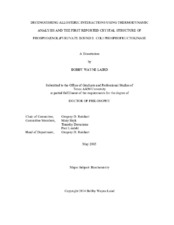| dc.description.abstract | To better understand the relationship between allosteric ligand structure and the resulting allosteric behavior, we investigated the roles that functional groups and structure play in the binding affinity and allosteric potency of ligands at the allosteric site of phosphofructokinase from E. coli (EcPFK). EcPFK is allosterically inhibited and activated in the presence of phospho-enol-pyruvate (PEP) and MgADP, respectively. Both activator and inhibitor bind to the same effector site and result in modification of the affinity for the substrate fructose-6-phosphate (F6P). The fact that both MgADP and PEP bind to the same binding site using a majority of the same residues, makes EcPFK an ideal system for this type of allosteric characterization.
In order to better understand the structural affects that PEP has on EcPFK, here we present the first study of the crystal structure of EcPFK that has been solved with PEP bound to the allosteric binding sites (EcPEP). The disproportionation reaction, EA + XE ↔ E + XEA, describes the equilibrium between the two binary complexes, i.e. the enzyme bound to substrate (EA) or allosteric effector (XE), on one side of the equilibrium and on the other side is the apo enzyme (E) and the ternary complex (XEA), i.e. where both substrate and allosteric ligand are bound. When accounting for the disproportionation equilibrium, the known crystal structures of EcPFK can be identified as a specific species and characterized independently of the other species. Given the disproportionation reaction, EcPEP is the only known crystal structure of an EcPFK binary complex. EcATC represents the ternary complex while EcApo represents the unbound enzyme.
To specifically address the roles of allosteric ligand functional groups, thermodynamic linkage analysis was used to examine wild type EcPFK in the presence of allosteric ligand analogs. This analysis allowed for a particular effector ligand functional group to be assigned as important to ligand binding, to allosteric coupling, to both binding and coupling, or to neither binding nor coupling. As a complement to the allosteric ligand analog study, we used thermodynamic linkage analysis to study EcPFK with mutations in the allosteric binding site. Specifically, position 58 was examined and compared to the allosteric ligand analog results. | en |


